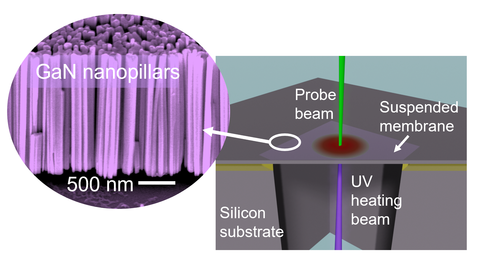Summary
Heat is carried in solid materials predominantly by atomic vibrational waves called phonons. Theory, simulations and experiments have shown that heat transport in a membrane can be slowed dramatically when there is phonon coupling between nanostructures and the membrane, without affecting the flow of electrons. This decoupling of electron and heat transport improves the performance of these materials in thermoelectric devices, which convert heat to electricity or vice versa, and has the potential to dramatically improve their performance. Thus nanostructured semiconductors can acquire new properties not predictable from their bulk counterparts, classifying them as metamaterials. Possible applications include waste heat recovery and cooling computer chips.
Description

About 68 % of the energy produced in the United States is wasted as heat lost to the environment. About a quarter of this lost heat is present at temperature gradients suitable for recovery with thermoelectric devices, which use the ability of semiconductors to generate electricity directly from heat. Widespread application of this technology has been limited by two factors— the low energy conversion efficiency for commercial thermoelectric devices (around 3 - 6 %) and the relatively high cost of those materials (bismuth telluride being the most common). The low efficiency and unusual materials are a consequence of the fact that to be a good thermoelectric material, that material must simultaneously be a good conductor of electricity and a poor conductor of heat, a combination that rarely happens because of the interconnection between scattering mechanisms for charge carriers and phonons.
This project seeks to use a new physical principle, the nanophononic metamaterial, to create ultra-high efficiency thermoelectric devices from lower cost materials, including silicon. To do so, we reduce the thermal conductivity of a material by adding resonating nanostructures on the sidewalls to slow the heat-carrying phonons down, while leaving the electrical properties unaffected. In a collaboration with Prof. Mahmoud Hussein at the University of Colorado Boulder, we made the first experimental demonstration of the theoretical principle first revealed in Hussein’s theory and molecular dynamics simulations by growing tiny pillars of GaN on thin silicon membranes (see figure). As shown in a paper soon to appear in Advanced Materials, we demonstrated a reduction in thermal conductivity of 21 % with no change in electrical conductivity or Seebeck (thermopower) coefficient.
In 2019, the collaboration expanded under funding from ARPA-E to extend this work to all-silicon structures and to include packaging innovations. This program produced structures with thermal conductivities as low as 5 W m-1 K-1, as compared with bulk silicon thermal conductivity on the order of 150 – 180 W m-1 K-1. The nanophononic metamaterial effect accounts for an 85 % reduction in thermal conductivity beyond the reduction typically observed in making a conventional thin membrane. This work has produced one joint patent so far, “Thermoelectric devices based on nanophononic metamaterials,” US Patent 11588091.

